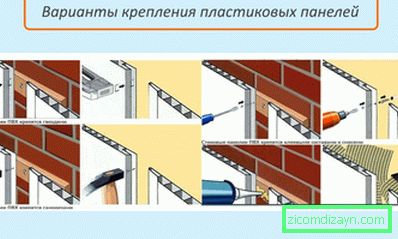Self-finishing the bathroom with plastic panels
The advanced achievements in the construction sphere are firmly entrenched in human life, that is why even today special bathroom finishes are made for the bathroom. They have not only protective, but also decorative characteristics. In the modern world, the most popular building material for wall finishing in a bathroom is a panel based on polyvinyl chloride.

Wall panels - an excellent option for finishing the bathroom, tk. They are practical, durable and have high water resistance.
Selection of panels
The main advantage of plastic panels for cladding is low cost. This is an excellent replacement for expensive tiles, which not everyone can afford.
When choosing a material, it is first of all necessary to focus on personal preferences. It should be borne in mind that lighter shades visually increase the bathroom, so with small dimensions of the room it is recommended to select white panels.
In the next turn, you need to pay attention to the uniformity of the plastic panel, since a bumpy surface with a characteristic pattern will collect more moisture, which will lead to the formation of mold or fungus.

There is a large selection of plastic panels in color, pattern and shape.
Finishing methods
With panels it is easy enough to handle, so they can be arranged independently without outside help and professional knowledge.
Finishing the bathroom with plastic panels is done in two ways:
- landing on the glue;
- fastening on self-tapping screws.
Each method has its advantages and disadvantages. For example, the material planted with glue will, in the future, be more difficult to remove from the wall surface. A plastic panel, fastened with self-tapping screws, will require a lot of time to install. This is due to the need to drill a lot of holes through the entire area of the treated walls.
There is an easier method of fixing plastic panels, implying the placement of special profiles at the top, in the center and at the bottom of the wall. Such profiles can be bought in any construction market individually in the right amount.

Variants of fastening of PVC panels.
To increase the strength of fasteners, it is recommended to place profiles on the wall at intervals of 0.6-0.8 m.
The following tools are required for the job:
- electric drill;
- self-tapping screws;
- crosshead screwdriver;
- set of guides for PVC panels;
- construction knife;
- tape measure and pencil;
- sealant.
First of all, it is necessary to level the surface of the walls, otherwise during the installation, there may be difficulties in docking plastic panels. The first wall to be treated must be in front of the entrance door. Drill the holes for the fastening of the guides to start from the top of the wall.
Before drilling, you will need to mark out areas using a tape measure and a pencil so that the profiles are placed evenly. When the drilling is completed, it is necessary to place the profile on the surface of the wall and fix it with self-tapping screws whose diameter exceeds the hole size by 1 mm.
After fixing the profile frame, you can start placing plastic, which is screwed to the profiles in a specially designated place. PVC panels must be installed in order directly into the joint. To place them overlap is unacceptable.
In the end sections of the room, plastic panels are cut with a knife. At the same time, gaps may appear in the corner joint due to uneven walls. They must be closed with special corners, which come complete with panels. It is desirable to put the corners on the sealant, this will help prevent the liquid from getting into the plastic panel.
PVC panels are installed very simply, most importantly - follow all the instructions in the manual.